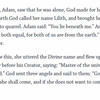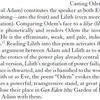5: "Lilith," "Alphabet of Ben Sira" 23a-b, and text excerpt, Zohar Weiman-Kelman's "Touching Time," 2017.
Building upon the study of intertextuality, there is another traditional text that can be read alongside Dropkin’s poem: the tale of Lilith. The tale of Lilith in Jewish folklore, as it has been popularized today, appears first in the Alphabet of Ben Sira (an anonymous medieval text inspired by the ethical writings of the scribe Ben Sira.) According to this story, Lilith is Adam’s first wife, created at the same time and from the same clay as Adam. She refuses to be subservient to Adam, and flees when she is not granted equal standing. Aside from this story, Lilith is depicted in folktales and popular culture as an infamous demon, associated with promiscuity, and accused of harming children and stealing babies in the darkness; however, she has also been adapted as a positive symbol of feminine strength, as in the feminist magazine Lilith.
Suggested Activity: Read the story and summarize the Lilith narrative. Ask students: how does this narrative differ from the biblical passage in resource 4? How does Dropkin’s poem draw from and/or disrupt Jewish textual descriptions of creation, gender, and sexuality? How might the poem reference Lilith and/or Eve? Who do you think is the speaker in the poem?
Then invite students to read the text excerpt from Zohar Weiman-Kelman's article "Touching Time." Ask students: what is Weiman-Kelman’s argument about the poem? How does the author connect the poem's relationship to Jewish texts and a Jewish past? Weiman-Kelman argues that the poem dissolves historical distance between its contemporary audience and Dropkin’s era, “activating” both the bodies and imaginations of readers in the present. Do Weiman-Kelman's arguments and insights differ from Kathryn Hellerstein's in resource 2? If so, how?
Sources: Rabbi Jill Hammer, “Lilith, Lady Flying in Darkness,” My Jewish Learning, accessed January 8, 2019. https://www.myjewishlearning.com/article/lilith-lady-flying-in-darkness/.
Zohar Weiman-Kelman, “Touching Time,” Criticism Vol. 59, No. 1 (Winter 2017), 103.


